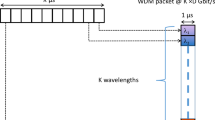Abstract
The optical layer of the transport network is expected in the (near) future to make the transition from a statically configured layer to a fully flexible, automatic and intelligent layer. Such an intelligent optical network (ION) allows to set up (or tear down) bandwidth between two nodes on demand, following a simple request of the client network layer: the so-called switched connections. For successful deployment of these switched connections it is of utmost importance to have a well-educated idea about the granularities of the traffic flows in the optical transport network. Deploying switched connections with a capacity of 10 Gbps to transport a traffic demand with a granularity of a few hundred Mbps does not exactly make efficient use of the network resources. In this paper, the granularity of the traffic demand between US metro areas is investigated for two future points in time, namely 2006 and 2010. For this study we focus on the traffic flows between two metro area entities: the points of presence (PoPs) or the main aggregation points of the customer traffic in a metro area, and the collector central offices (COs) or the nodes a bit further in the metro area, closer to the end-customers. We have found that a significant portion of the total traffic volume at these moments in time will qualify for transport using switched connections with a capacity of 10 Gbps. According to our study, in 2006 around one third of the traffic will qualify for transportation in such 10 Gbps connections between PoPs in different metro areas, while by 2010 this amount will have increased to more than 99%. The traffic granularity between the collector COs, however, will in 2006 still be too small to justify the use of direct 10 Gbps connections, but in 2010 almost three quarter of the traffic could make use of 10 Gbps direct connections from collector CO to collector CO. These results enable us to sketch the expected network evolution scenario and determine the type and size of equipment needed in the different steps of the network evolution. The optical edge aggregation switches will have to be moved deeper into the metro area with time: in 2006 they will be needed at the PoPs, while by 2010 they could be placed at the collector COs.
Similar content being viewed by others
References
L. Roberts, C. Cnimp, US Internet IP traffic growth, available at http://www.caspiannetworks.com/library/presentations/ traffic/lnternet_1raffic_081301.ppt., (August 2001).
"Is your slice of the global market big enough?", Telecommunications International, vol. 37, no. 5, (May 2003), pp. 14–16.
S. De Maesschaick, et al., Intelligent optical networking for multi-layer survivability, IEEE Communications Magazine, vol. 40, no. I, (Jan. 2002), pp. 42–49.
Proc. IST-LION/IST-OPTIMIST Workshop on Intelligent High-Capacity Optical Networks: Opportunities and Challenges, (Turin, Italy, Oct. 2002), available at http:// www.telecomitalialab.com/congressi_e.htm.
ITU-T Rec. G.8080/Y.1304, Architecture for the Automatic Switched Optical Network (ASON) (Nov. 2001).
E. Mannie (ed.). Internet Draft, Generalized Multi-Protocol Label Switching Architecture, available at draft-ietf-ccamp-gmpls-architecture-06.txt (April 2003).
OIF-UNI-Ol.O—User Network Interface (UNI) 1.0 Signaling Specification, (October 2001), available at http://www.oifor-urn.com/public/docurnents/OIF-UNI-OI.O.pdf.
S. De Maesschaick, D. Colle, D. Willems, M. Pickavet, P. Demeester, On the capacity requirements of ASONs versus OTNs, Proc. of HSNMC 2003, (Estoril, Portugal, July 2003), pp. 416–25.
A. Dwivedi, R. E. Wagner, Traffic model for USA LH optical network, Proc. of OFC 2000, (Baltimore, U.S.A., March 2000), vol. I, TuKI-I, pp. 156–158.
M. Vaughn, M. Chia, R. E. Wagner, A bottom-up traffic demand model for long-haul and metropolitan optical networks, Proc. of OFC 2003, (Atlanta, U.S.A., March 2003), MFIII.vol. I, pp. 139–140.
The telecom depression, when will it end, Businessweek, (October 2002), pp. 90–96.
R. E. Wagner, L. Nederlof, M. Vaughn, S. De Maesschaick, D. Cotter, B. Hemenway, Interconnection of metropolitan and backbone networks, Proc. of OFC 2003, (Atlanta, U.S.A., March 2003), ThHI, vol. 2, pp. 479–80.
M. Vaughn, R. E. Wagner, Metropolitan network traffic demand study, Proc. ofLEOS 2000, (Rio Grande, Puerto Rico, November 2000), MK4, vol. I, pp. 102–103.
Cambridge Strategic Management Group.
S. Bartholomew, The art of peering, BT Technology Journal, vol. 18, no. 3, (July 2000), pp. 33–39.
G. Huston, Interconnection, peering, and settlements, Proc. of INET '99, (San Jose, U.S.A., June 1999), available at http:// www.potaroo.net/papers/inet99/peering.htm.
W. Norton, Internet Service providers and peering, available at http://netweb.usc.edu/cs551/papers/norton-peering-wp01.pdf.
W. Norton, The art of peering: The peering playbook, available at http://www.xchangepoint.net/white_papers/ wp20020625.pdf.
http://www.colosource.com/ix.asp
R. E. Wagner, Optical network architectures, Proc. of NOC 2001, (Ipswich, UK, June 2001), pp. 22–29.
R. E. Wagner, L. Nederlof, M. Vaughn, S. De Maesschaick, D. Cotter, B. Hemenway, The potential of optical layer network, Proc. of OFC 2001, (Anaheim, U.S.A., March 2001), TuT3, vol. 2, pp. Tl–3.
Author information
Authors and Affiliations
Rights and permissions
About this article
Cite this article
Maesschalck, S.D., Nederlof, L., Vaughn, M. et al. Traffic Studies for Fast Optical Switching in an Intelligent Optical Network. Photonic Network Communications 8, 285–307 (2004). https://doi.org/10.1023/B:PNET.0000041239.57221.1a
Issue Date:
DOI: https://doi.org/10.1023/B:PNET.0000041239.57221.1a




